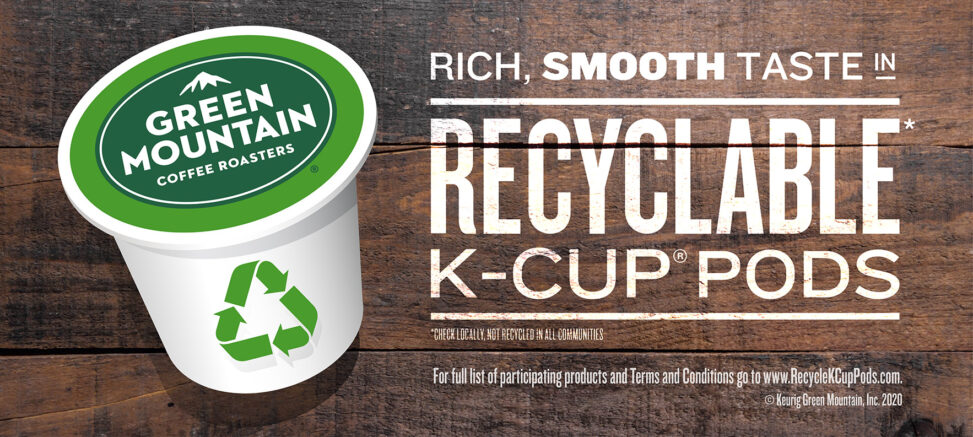Pictured above is an advertisement made by the American company Keurig Dr Pepper (this will be referred to simply as “Keurig” from now on) in a 2021 campaign advertising their “recyclable” K-cup pods.
Launched in 2016, the K-cup pods were promised to be made 100% of recyclable plastic¹, an environmentally friendlier alternative to the ubiquitous disposable coffee pods posing harm to the planet.
The marketing campaign, which consisted of still, image-focused advertising, was spread across various physical and online platforms, from newspapers to social media and mass email blasts.² Its main goal was to sell its K-cup pods as not only a quality brand of coffee, but one that does not require its consumers to sacrifice their moral and ethical sensibilities for convenience.
The advertisement I have chosen to analyse features three main parts: a pictorial depiction of the K-cup pod to the left of the foreground, a block of writing describing the product to the right of the foreground, and a solid background made of what appears to be roughly joined wooden planks.
The use of colour in this advertisement is simple but calculated. The only colours present—albeit in varying shades—are brown, green, and white. All three colours evoke a feeling of earthiness and connection with nature, especially when brought together as it is here. The bright green on the K-cup pods, in particular, is reminiscent of the “green thumb” imagery. Paired with the familiar chasing arrow symbol of recycling on its body, the message the coffee pod sends is one of an eco-conscious, environmentally responsible product.
The coffee pod is, of course, a major focal point of this image, as one’s eyes are immediately drawn to it. Another focal point would be the word “recyclable”, which is written to be bolder and larger than any other word. The goal of these two focal points is for the viewer to connect the K-cup pods with recycling. It is an effective example of visual marketing because a quick glance immediately communicates its message.
Though in the background of the image, the wooden surface is another important focal point that contributes to the advertisement’s message and brings it all together. Its aged, wooden texture is reminiscent of tree bark and old wooden boardwalks. It suggests a version of nature that is untampered with, giving the impression that its product is respectful of the environment and does not bring harm to it. Some of the words in the foreground seem to blend slightly or are cut into by the background, which could imply the willingness of the brand to work “in tune with” these natural elements rather than in opposition to them.
It is also important to note the tiny bit of writing just under the largest words on the image. It says: “*Check locally, not recycled in all communities” in small lettering that blends with the background and is difficult to read. The company’s target audience consists of people who enjoy coffee and likely already use single-serving coffee pods like the K-cup pods. According to the United States Securities and Exchange Commission, environmental concerns were “a significant factor that certain consumers considered, among others, when deciding whether to purchase a Keurig brewing system.”³ Keurig’s advertising campaign targets those specific customers, reassuring them that their purchasing decision is not harmful to the ecosystem. Many customers, therefore, are eager for positive reinforcement and may not struggle too hard to decipher the caveat written in tiny letters. Instead, they may take all other visual cues (as analysed above) at face value and believe in the message Keurig is selling. The message being that using their K-cup pods is environmentally responsible.
The reality is much less uplifting. Keurig’s K-cup pods are single-use, single-serving containers. According to experts, coffee pods such as Keurig’s use more non-biodegradable materials than other coffee-making options, on top of also being difficult to separate and recycle.⁴ Further, the preparation of these pods typically accounts for more greenhouse emissions than other means of coffee preparation.⁵ Research has also shown that the cultivation of coffee itself has considerable adverse effects on the environment as a result of fossil-derived fertilisers.⁶ Altogether, the overall ecological impact of the entire coffee-pod system is the most ecologically unfriendly of all alternate means of coffee making.⁷
In January 2022, Keurig Canada was fined $3 million by the Competition Bureau, who claimed they had misled the public by insisting their pods were recyclable.⁸ In September of 2024, Keurig settled with the SEC for $1.5 million after they were alleged to have deceived the American public despite receiving significant concerns from major recycling companies about the feasibility of their project.⁹
This advertisement feels extremely exploitative because it is clearly preying on the sensibilities of well-meaning, eco-conscious people who want to take strides to help the planet. Studies have shown that the environmental effect of simply brewing a coffee using a coffee pod does not inherently lead to greater environmental damage, and that, “although the technology utilised to brew the coffee is relevant to the environmental impact, the human usage of the technology is also equally relevant.”¹⁰ As opposed to educating their consumer base on the most environmentally conscious ways to use these products, Keurig utilised greenwashing; weaponizing consumer anxieties for a money-making scheme.
Notes
¹ Louise Dickson, “UVic Law Team Triggers Landmark Decision Over Plastic Coffee Pods,” Times Colonist, January 10, 2022, https://www.timescolonist.com/local-news/uvic-law-team-triggers-landmark-decision-over-plastic-coffee-pods-4936478.
² Matt, “Keurig Fined CA$ 3 Million for False Advertising,” ELAW: Environmental Law Alliance Worldwide, January 17, 2024, https://elaw.org/keurig-fined-ca-3-million-false-advertising.
³ U.S. Securities and Exchange Commission, “SEC Charges Keurig with Making Inaccurate Statements Regarding Recyclability of K-Cup Beverage Pod,” Press release, September 10, 2024, accessed September 30, 2024, https://www.sec.gov/newsroom/press-releases/2024-122.
⁴ Andrea L. Hicks, “Environmental Implications of Consumer Convenience: Coffee as a Case Study,” Journal of Industrial Ecology 22, no. 1 (January 22, 2017): 79–91, https://doi.org/10.1111/jiec.12487.
⁵ Matteo Cibelli et al., “Carbon Footprint of Different Methods of Coffee Preparation,” Sustainable Production and Consumption 27 (April 6, 2021): 1614–25, https://doi.org/10.1016/j.spc.2021.04.004.
⁶ Martin R.A. Noponen et al., “Greenhouse Gas Emissions in Coffee Grown with Differing Input Levels Under Conventional and Organic Management,” Agriculture Ecosystems & Environment 151 (February 24, 2012): 6–15, https://doi.org/10.1016/j.agee.2012.01.019.
⁷ Andrea L. Hicks and Heather Halvorsen, “Environmental Impact of Evolving Coffee Technologies,” The International Journal of Life Cycle Assessment 24, no. 8 (January 8, 2019): 1396–1408, https://doi.org/10.1007/s11367-018-1575-0.
⁸ Dickson, “UVic Law Team Triggers Landmark Decision Over Plastic Coffee Pods,” January 10, 2022.
⁹ Camilo Fonseca, “Keurig Claimed Its K-cup Pods Were Recyclable. The SEC Says That’s Not Quite True.,” The Boston Globe, September 10, 2024, https://www.bostonglobe.com/2024/09/10/business/keurig-coffee-pods-recycling-sec/.
¹⁰ Hicks, “Environmental Implications of Consumer Convenience: Coffee as a Case Study.”
Bibliography
Camilo Fonseca. “Keurig Claimed Its K-cup Pods Were Recyclable. The SEC Says That’s Not Quite True,” The Boston Globe, September 10, 2024, https://www.bostonglobe.com/2024/09/10/business/keurig-coffee-pods-recycling-sec/.
Camilo Fonseca. “Keurig Claimed Its K-cup Pods Were Recyclable. The SEC Says That’s Not Quite True,” The Boston Globe, September 10, 2024, https://www.bostonglobe.com/2024/09/10/business/keurig-coffee-pods-recycling-sec/.
Cibelli, Matteo, Alessio Cimini, Gabriella Cerchiara, and Mauro Moresi. “Carbon footprint of different methods of coffee preparation.” Sustainable Production and Consumption 27 (April 6, 2021): 1614-1625. https://doi.org/10.1016/j.spc.2021.04.004.
Hicks, Andrea L. “Environmental Implications of Consumer Convenience: Coffee as a Case Study.” Journal of Industrial Ecology 22, no. 1 (January 22, 2017): 79–91. https://doi.org/10.1111/jiec.12487.
Hicks, Andrea L., and Heather Halvorsen. “Environmental Impact of Evolving Coffee Technologies.” The International Journal of Life Cycle Assessment 24, no. 8 (January 8, 2019): 1396–1408. https://doi.org/10.1007/s11367-018-1575-0.
Louise Dickson. “UVic Law Team Triggers Landmark Decision Over Plastic Coffee Pods.” Times Colonist, January 10, 2022. https://www.timescolonist.com/local-news/uvic-law-team-triggers-landmark-decision-over-plastic-coffee-pods-4936478.
Maggie Keenan. “Keurig Fined CA$ 3 Million for False Advertising.” ELAW: Environmental Law Alliance Worldwide, January 17, 2024. https://elaw.org/keurig-fined-ca-3-million-false-advertising.
Noponen, Martin R.A., Gareth Edwards-Jones, Jeremy P. Haggar, Gabriela Soto, Nicola Attarzadeh, and John R. Healey. “Greenhouse Gas Emissions in Coffee Grown With Differing Input Levels Under Conventional and Organic Management.” Agriculture Ecosystems & Environment 151 (February 24, 2012): 6–15. https://doi.org/10.1016/j.agee.2012.01.019.
U.S. Securities and Exchange Commission. “SEC Charges Keurig With Making Inaccurate Statements Regarding Recyclability of K-Cup Beverage Pod.” Press release, September 10, 2024. Accessed September 30, 2024. https://www.sec.gov/newsroom/press-releases/2024-122.


Provide Feedback